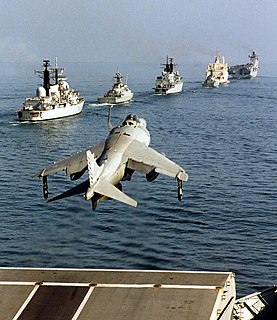
A short take-off and vertical landing aircraft is a fixed-wing aircraft that is able to take off from a short runway and land vertically. The formal NATO definition is:
A Short Take-Off and Vertical Landing aircraft is a fixed-wing aircraft capable of clearing a 15 m obstacle within 450 m of commencing take-off run, and capable of landing vertically.

Takeoff is the phase of flight in which an aerospace vehicle goes from the ground to flying in the air.

A vertical and/or short take-off and landing (V/STOL) aircraft is an airplane able to take-off or land vertically or on short runways. Vertical takeoff and landing (VTOL) aircraft are a subset of V/STOL craft that do not require runways at all. Generally, a V/STOL aircraft needs to be able to hover. Helicopters are not considered under the V/STOL classification as the classification is only used for airplanes, aircraft that achieve lift (force) in forward flight by planing the air, thereby achieving speed and fuel efficiency that is typically greater than the capability of helicopters.

The Rolls-Royce Pegasus, formerly the Bristol Siddeley Pegasus, is a turbofan engine originally designed by Bristol Siddeley. It was manufactured by Rolls-Royce plc. The engine is not only able to power a jet aircraft forward, but also to direct thrust downwards via swivelling nozzles. Lightly loaded aircraft equipped with this engine can manoeuvre like a helicopter. In particular, they can perform vertical takeoffs and landings. In US service, the engine is designated F402.

The Hawker P.1127 and the Hawker Siddeley Kestrel FGA.1 are the experimental and development aircraft that led to the Hawker Siddeley Harrier, the first vertical and/or short take-off and landing (V/STOL) jet fighter-bomber. P.1127 development began in 1957, taking advantage of the Bristol Engine Company's choice to invest in the creation of the Pegasus vectored-thrust engine. Testing began in July 1960 and by the end of the year the aircraft had achieved both vertical take-off and horizontal flight. The test program also explored the possibility of use upon aircraft carriers, landing on HMS Ark Royal in 1963. The first three aircraft crashed during testing, one at the 1963 Paris Air Show.

The Ryan XV-5 Vertifan was a jet-powered V/STOL experimental aircraft in the 1960s. The United States Army commissioned the Ryan VZ-11-RY in 1961, along with the Lockheed VZ-10 Hummingbird.

The Lockheed XV-4 Hummingbird was a U.S. Army project to demonstrate the feasibility of using VTOL for a surveillance aircraft carrying target-acquisition and sensory equipment. It was designed and built by the Lockheed Corporation in the 1960s, one of many attempts to produce a V/STOL vertical take off/landing jet. Both prototype aircraft were destroyed in accidents.

The Dornier Do 31 was an experimental vertical take-off and landing (VTOL) jet-propelled transport designed and produced by West German aircraft manufacturer Dornier.

The Short SC.1 was the first British fixed-wing vertical take-off and landing (VTOL) jet aircraft. It was developed by Short Brothers. It was powered by an arrangement of five Rolls-Royce RB108 turbojets, four of which were used for vertical flight and one for conventional horizontal flight. The SC.1 had the distinction of being the first British fixed-wing VTOL aircraft and the first one to transition between vertical and horizontal flight modes; it was also the first VTOL-capable aircraft with a fly-by-wire control system.

Powered lift or powered-lift refers to a type of aircraft that can take off and land vertically and functions differently from a rotorcraft in horizontal flight.

The Hawker Siddeley HS.141 was a 1970s design study and submission for a British V/STOL airliner requirement. Designed by Hawker Siddeley Aviation and tested in wind tunnels neither prototypes nor production aircraft were produced.
Aircraft can have different ways to take off and land. Conventional airplanes accelerate along the ground until sufficient lift is generated for takeoff, and reverse the process to land. Some airplanes can take off at low speed, this being a short takeoff. Some aircraft such as helicopters and Harrier Jump Jets can take off and land vertically. Rockets also usually take off vertically, but some designs can land horizontally.

The Vertical Take-Off and Landing Experimental Aircraft program is an American research project sponsored by the Defense Advanced Research Projects Agency (DARPA). The goal of the program is to demonstrate a VTOL aircraft design that can take off vertically and efficiently hover, while flying faster than conventional rotorcraft. There have been many previous attempts, most of them unsuccessful.

The Xplorair is a project of compact VTOL aircraft without rotating airfoil from aerospace engineer Michel Aguilar, funded by the French Armed Forces procurement agency DGA and supported by various European aeronautics firms such as Dassault Systèmes, EADS Innovation Works, MBDA, Altran Technologies, Sogeti, Turbomeca, COMAT Aerospace and the Institut Pprime. Announced in 2007, the project aimed to develop a UAV prototype scheduled for flight in 2017, followed by a single-seater flying car whose commercialization could occur the decade after.
Lift fan is an aircraft configuration in which lifting fans are located in large holes in an otherwise conventional fixed wing or fuselage. It is used for V/STOL operation.
The Lilium Jet is a proposed German vertical take-off and landing electrically powered aeroplane designed by Lilium GmbH.

The Airbus Vahana is an electric-powered eight-propeller vertical take-off and landing aircraft prototype financed by A³ by Airbus and Airbus Urban Mobility. Vahana project started in 2016 as one of the first projects at A³, the advanced projects and partnerships outpost of Airbus Group in Silicon Valley. Airbus "envision[s] Vahana being used by everyday commuters as a cost-comparable replacement for short-range urban transportation like cars or trains".
The Boeing Passenger Air Vehicle (PAV) is an American autonomous personal air vehicle prototype developed by the Boeing NeXt division of Boeing with the assistance of Aurora Flight Sciences.

The XTI TriFan 600 is a vertical takeoff and landing aircraft designed by Denver-based XTI Aircraft Company.
















